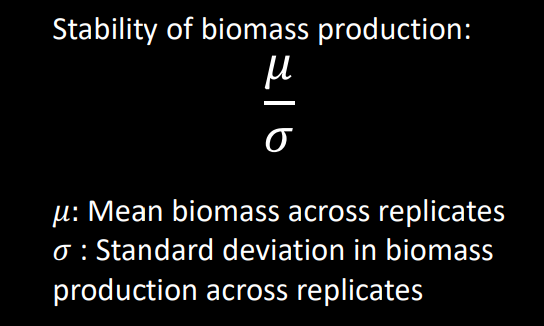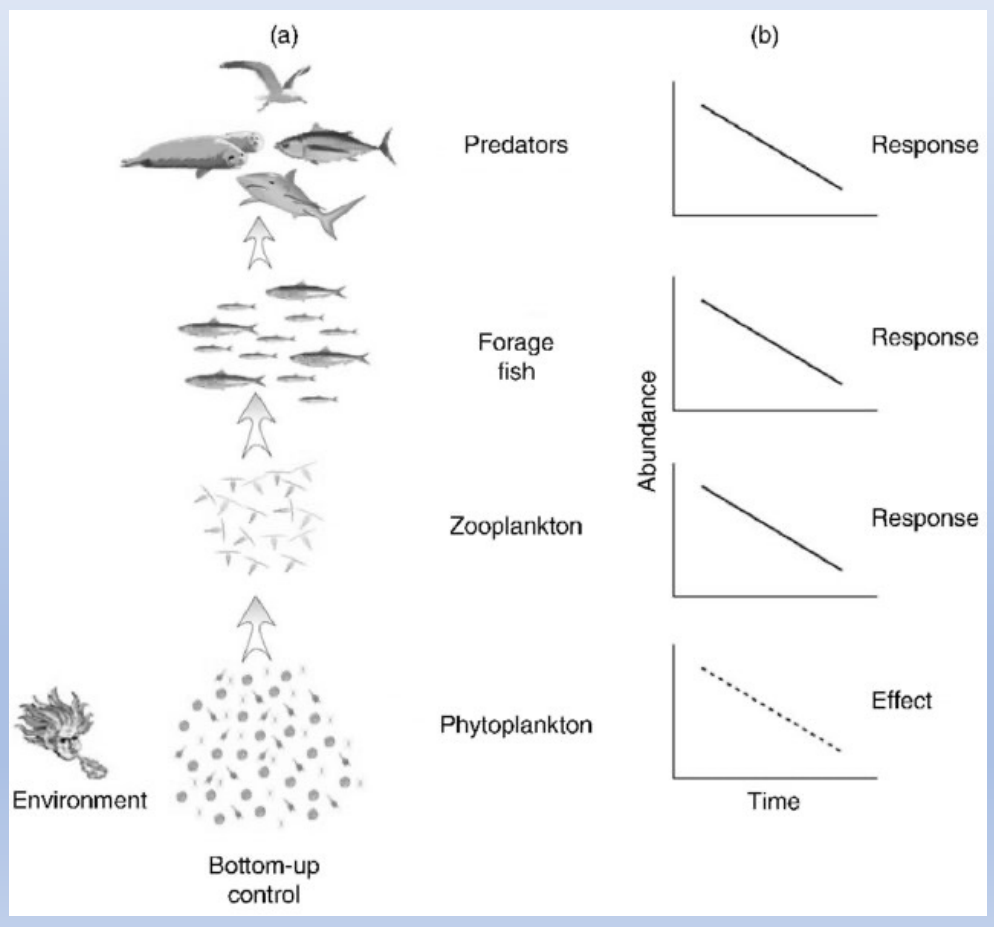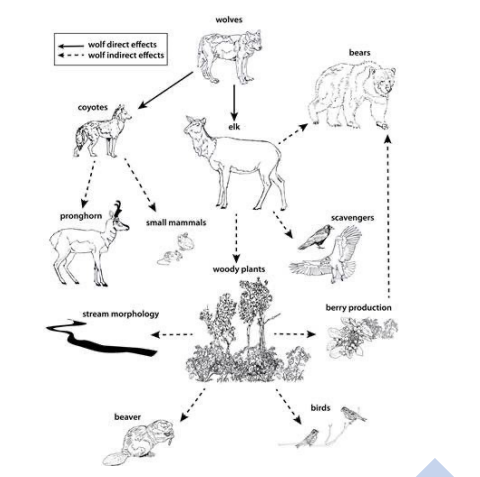Week 6: Mutualisms and Food Web Stabiltiy
1/49
There's no tags or description
Looks like no tags are added yet.
Name | Mastery | Learn | Test | Matching | Spaced |
|---|
No study sessions yet.
50 Terms
Mutualisms
both species have a dependency on each other→ net positive effect of partnership
When should we expect mutualisms
Under stressful conditions
Increasing physical stress, increasing the frequency of positive interactions → neighbourhood habitat amelioration
Increasing consumer pressure, decreasing the frequency of competitive interactions → associational defences
Neighborhood Habitat Amelioration
improving a local habitat
Associational Defenses
Protection gained by an organism from living in association with another species
Is mutualism obligate?
Cannot grow without the other species
Consequences
Below threshold: extinction
Above threshold: unlimited growth
Unrealistic (lots of mutualisms)→ scenarios not found in natural world
Positive feedback (density dependence) is problematic in these very simple models
Do Lotka- Volterra models work for mutualism?
tend to lead to silly solutions in which both populations undergo unbounded exponential growth, in an orgy of mutual benefaction
non-linear response required
cannot benefit forever
saturation of benefit
Empirical examples of mutualisms: Pollination
Pollen transfer
Nectar
Rapid diversification of flowers (angiosperms) 90-130 mya coincides with boom in insect species
Specialist pollinator
Fig & fig wasp
700 spp of fig: 1-2 pollinator sp
Are figs full of dead wasps?
No. Ficin released by the plants decomposes the bodies
Fig wasp sex ratio
sex ratio skewed to females
male hatches→ blind + wingless → fertilises females → burrows a hole in fruit for females then die
Generalist pollinator
Honey bees (Apis mellifera)
100s plants
Empirical examples of mutualisms: Coral- Algae
can exist without each other but better together→ coral may have negative growth without algae + algae may take up minerals from water via diffusion → very slow process
Facultative/Obligate symbiosis
Algae can leave when conditions not right (bleaching of coral)
Coral can feed by predation on plankton (but growth is slow or even negative)
The Role of Coral
obtain photosynthate (carbon)
sieve out minerals from huge volume of water that passes over via wave action
coral reefs: clear water, shallow as wave action required
The role of algae (zooxanthellae)
Factory for turning sunlight in C
Obtain minerals extracted from sea by coral
Free living individuals rely upon diffusion from nearby surrounding water (slow)
Empirical examples of mutualisms: Plants- Fungi
Fungi → photosynthates i.e carbon
Plant → soil nutrients
Xanthoria parietina
common pollution tolerant lichen found on trees across London
How old/ widespread is plants- fungi mutualism?
Fossil evidence → 400 Mya
Nutrient deficient soils
Sand dunes
Tropical rainforests(!)
Orchid mycorrhizas
Some orchids non-photosynthetic
Most chlorophyll only after seedling
Obligate mutualist
Seeds –size of dust particles
Very little nutrients
Produce large number
Good for colonisation
Will not germinate without fungal infection
Obtain carbon from fungus
Parasitise other plants via fungal network (Also mutualism with pollinators)
mycoheterotrophic orchid
no leaves
can’t fix carbon
e.g Erythrorchis altissima (Asia)
decomposes wood on tree
requires saprophytic fungi to germinate and grow
Arbuscular mycorrhizas (AM)
majority of wild and crop plants
Facultative
Within plant cell → 20% of plant-fixed carbon transferred to fungus
Oldest type (fossils)
AM Function: Root morphology modification and development of a complex, ramifying mycelial network in soil
Ecosystem service: increase plant/ soil adherence and soil stability
AM Function: Increasing mineral nutrient + water uptake by plants
Promote plant growth while reducing fertiliser requirement
AM Function: Buffering effect against abiotic stresses
Increased plant resistance to drought, salinity, heavy metals pollution and mineral nutrient depletion
AM Function: Secretion of ‘glomalin’ into the soil
Increased soil stability and water retention
AM Function: Protecting against root pathogens
Increased plant resistance against biotic stresses while reducing phytochemical input
AM Function: Modification of plant metabolism and physiology
Bioregulation of plant development and increase in plant quality for human health
Ectomyccorhiza
less common than arbuscular mycorrhizas
10% plant families
Basidiomycota, Ascomycota, and Zygomycota
Hartig net
wraps round roots of plant → interface of plant and fungus
does not penetrate→ more generalist interaction
Experiment to show effect on competition
2 plants; 2 soils (high, low sand)
4 fungi 5 ratios of seedlings (8:0; 6:2; 4:4; 2:6; 0:8)
plants will compete → seed ratios manipulated→ dominating plant
trifolium good at fixing nitrogen from air
good in nutrient poor soil
pioneer species → dies → nitrogen in soil
high sand = nutrient deficient
low sand = high nutrients
Trifolium – N-fixer - did better with mycorrhizae, high sand (low soil nutrient)
Trifolium does bad without fungus
Lolium did better with Trifolium. Better with no mycorrhizae→ mycorrhizae manipulates interaction
Mixed communities produce higher yields. Mycorrhizal fungi improve community yield.
Importance of “Higher order interactions” species A outcompetes species B, but not in presence of species C
Mutualism Summary
Basic theory works with saturation of benefit
Widespread
Generalists –facultative
Specialists –obligate
Responsible for angiosperm diversification
Interesting evolutionary dynamics (cheaters can destroy the mutualism)
Mutualisms can mediate competition within and between species
Higher order interactions (> 2 species)
Diversity of plants dependent upon mutualists?
What do most food web studies not take into account?
parasites/ pathogens
Questions about diversity- stability
Are more diverse ecosystems more stable?
Does removing species risk ecosystem meltdown?→ anthropomorphic pressure
How many species can we lose?
Are there any particular species we need to keep?
Which is stabler: simple communities or richer ones?
simple communities less stable
more subjected to destructive oscillations in populations
more vulnerable to invasions
What is stability?
Species-level eg chaos, limit cycles
Community eg stable community states
Multiple stable states
Fluctuations –intrinsic e.g oscillations predator-prey
Fluctuations –extrinsic→ environmental conditions→ climate change
Press perturbations→ e.g climate change/ global warming→ things slowly getting worse
(Removal) Extinction of species
Invasion of new species
Example of a system with multiple stable states
Coral reefs, Parrot fish, Diadema
Mumby et al. (2007)
Theoretical Results on Stability Using Lotka Volterra Models
Using Lotka-Volterra models and random interactions (ie attack rates etc assigned random numbers)
Mixed messages
more diverse communities less stable
a(SC)1/2 <1 for stability (Bob May 1976)
a: average interaction strength→ strong interactions → harder for system to be stable
S: species number→ many species = less stable
C: connectance (interactions between species)→ more= less stability
Want S to be big → average interaction strength down and vice versa→ trade off
Why might stability with L-V be different to expected results?
Recent theory:
Lots of weak interactions, omnivory -> stability at high diversity
omnivores→ multiple trophic levels → important
Interactions assigned randomly → not replicate of natural world
Experiment on L-V Theory (Kokkoris et al.1999)
Build communities using L-V competition models
Assign interaction (competition) strengths from random pool of numbers.
Build communities by adding in successive species→ looked at sequential arrival of species
Keep track of average interaction strength
Result:
Average interaction strength decreased as communities got bigger→ fits with Bob Mays results
Few new species could invade = resilience?
Food Web Stability: Empirical Webs (Yodzis, 1981)
40 published food webs
Assigned interaction strengths to L-V consumer-resource model
Strong intraspecific interference stabilised dynamics
Strong interspecific interference de-stabilize i.e weak interspecific interactions stabilise
St Martin’s Food web
Goldwasser and Roughgarden Ecology, Vol. 74, (Jun., 1993)
Food web on Caribbean islands
Lizards; kestrels; spiders; hummingbirds; butterflies; snails; mites
Strength estimated by gut contents; hunting preference etc
Diversity- Stability Consequences
Weak interactions dominate
Lots of weak interactions stabilise
Generalist predators stabilise
Specialists lead to instability
Invader can destabilise community if interaction variability increased
Could be weak/strong interactions
Species removal increases mean interaction strength
Fewer links
Community becomes LESS stable
McCann (2000) Science
Empirical Evidence: Tropical Rain Forest
Asymmetric density dependence shapes species abundances in a tropical tree community
Comita et al. 2010 Science
Barro Colorado Island, Panama
50Ha plot
Every individual tree recorded every 5 years since 1981 300,000 individuals
300sp tree (<100 in North America)
Seedling experiment Effect of conspecific & heterospecific seedling & adult neighbours on seedling survival over 5 years
31,000 seedlings; 180sp
Results
Conspecific effects much stronger than heterospecific effects
Heterospecific effects much less variable
Are species rich communities more stable?
Tilman, D. et al. 2006
Dave tilman → permanent experiment - over 20 years
9x9m plots
Plots sown with 1, 2, 4, 8, or 16 species
Spp drawn at random
30 replicates for each level
Grasses (C3 and C4); legumes; woody species; forbs
10 years data
Environmental variation→ outside experiment not in a greenhouse
cf species v community stability
Results
Increase in community stability with increasing species richness
Decreasing species stability with increasing species richness
How were the results quantified? Tilman, D. et al. 2006
Community measure used = biomass production

Mechanism for community stability
portfolio effect
Portfolio Effect
In a diverse community- will always be a species that takes advantage of the environmental conditions so overall biomass stable → species producing biomass changes
Top Down Trophic Cascades
A top-down cascade is a trophic cascade where the top consumer/predator controls the primary consumer population
In turn, the primary producer population thrives

Bottom Up Trophic Cascades
change in nutrient supply leads to similar changes in equilibrium abundances at all trophic levels, at least until abundances are constrained by other factors

Example of Top Down Control: San Francisco Bay
Over-fishing
Reduces ‘normal’ prey for killer whales
Switch to sea otters
Sea urchins released from predation
Decimation of kelp forests
Relatively ‘simple’ food web
Fragile stability
Mesopredator release→ middle predator not top
Mangroves + kelp forests→ herbivore pressures → sea otters eat sea urchins
J. A. Estes et al. Science (1998)
Example of top predator re- introduction
Wolves reintroduced to Yellowstone in 1995
elk decline
browsing decreasing
aspen height increase
Cottonwood trees increase
Willow tree ring area increase
Number of beaver colonies increase
Bison increase

Examples of Bottom Up Control Baez et al. 2006
Exclosure experiment
Grass & shrub communities
(i) with rodents
(ii) without
No difference between treatments = no top down control
Rodent numbers dependent upon (current and previous year) precipitation